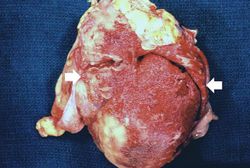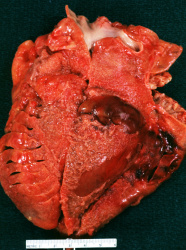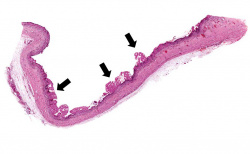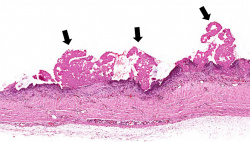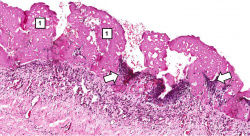IPLab:Lab 3:Fibrinous Pericarditis
Contents
Clinical Summary[edit]
This patient is a 36-year-old white male with a history of long-standing renal disease who presents with end-stage kidney disease and a BUN of 112 mg/dL. During the present hospitalization he developed a pericardial friction rub and pericardial and pleural effusions. A semi-elective pericardiectomy was performed.
Submitted for examination was a rectangular segment of gray-tan tissue measuring 9.5 x 8.5 x 0.3 cm. The outer surface was fatty in appearance. The inner surface was rough and covered by a number of fine red papillary projections. The projections were composed of fine strands having the appearance of fibrin.
Images[edit]
Virtual Microscopy[edit]
Study Questions[edit]
Additional Resources[edit]
Reference[edit]
- eMedicine Medical Library: Acute Pericarditis
- eMedicine Medical Library: Dialysis Complications of Chronic Renal Failure
- Merck Manual: Pericarditis
- Merck Manual: Chronic Kidney Disease: Renal Failure
Journal Articles[edit]
- Wood JE, Mahnensmith RL. Pericarditis associated with renal failure: evolution and management. Semin Dial 2001 Jan-Feb;14(1):61-6.
Images[edit]
Related IPLab Cases[edit]
A normal BUN for this patient would be 10 to 20 mg/dL.
A pericardial friction rub is the characteristic sign of pericarditis. It sounds like the rubbing together of two rough surfaces. The sound may vary over time and patient position.
Pleural effusion is the presence of fluid in the pleural space. Increased hydrostatic pressure in the pulmonary vasculature, as seen in heart failure, is one cause of pleural effusion.
A pericardiectomy is a surgical procedure in which the pericardial sac is opened, a piece is removed, and the sac is left open.
Pericarditis is inflammation of the pericardium - often with deposition of fibrin.
Myocardial infarction is necrosis of myocardial tissue which occurs as a result of a deprivation of blood supply, and thus oxygen, to the heart tissue. Blockage of blood supply to the myocardium is caused by occlusion of a coronary artery.
